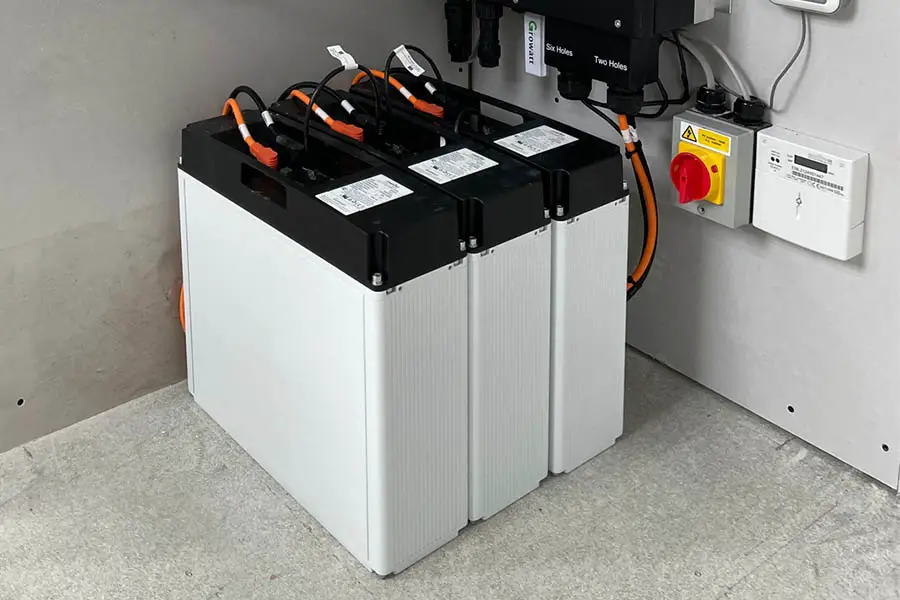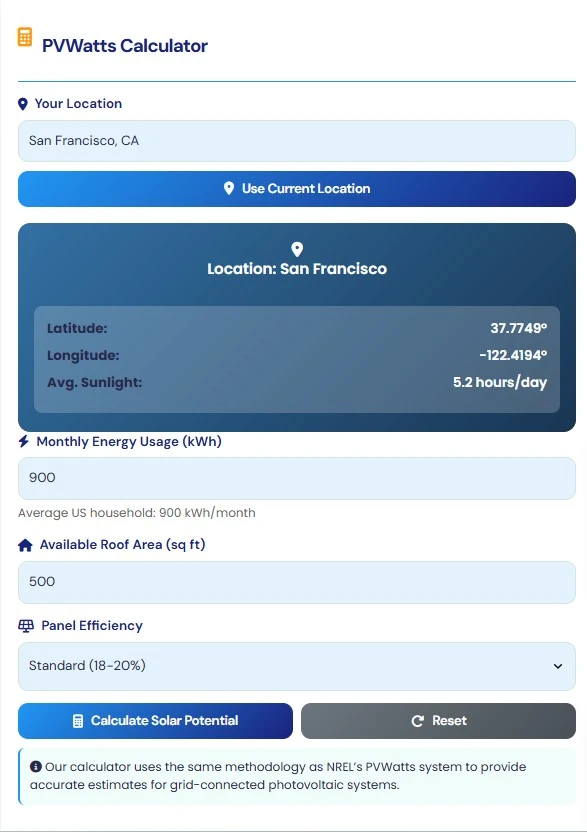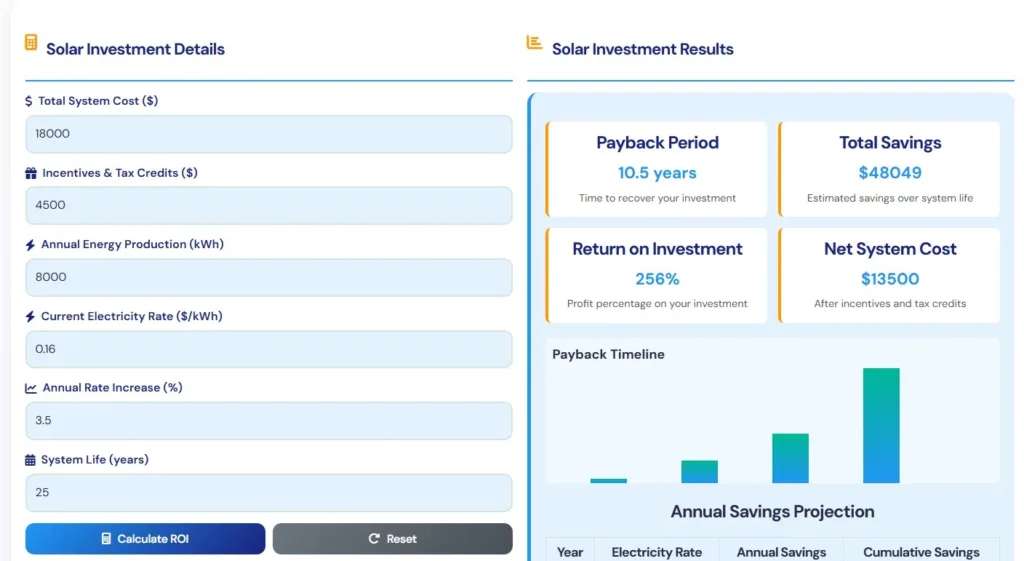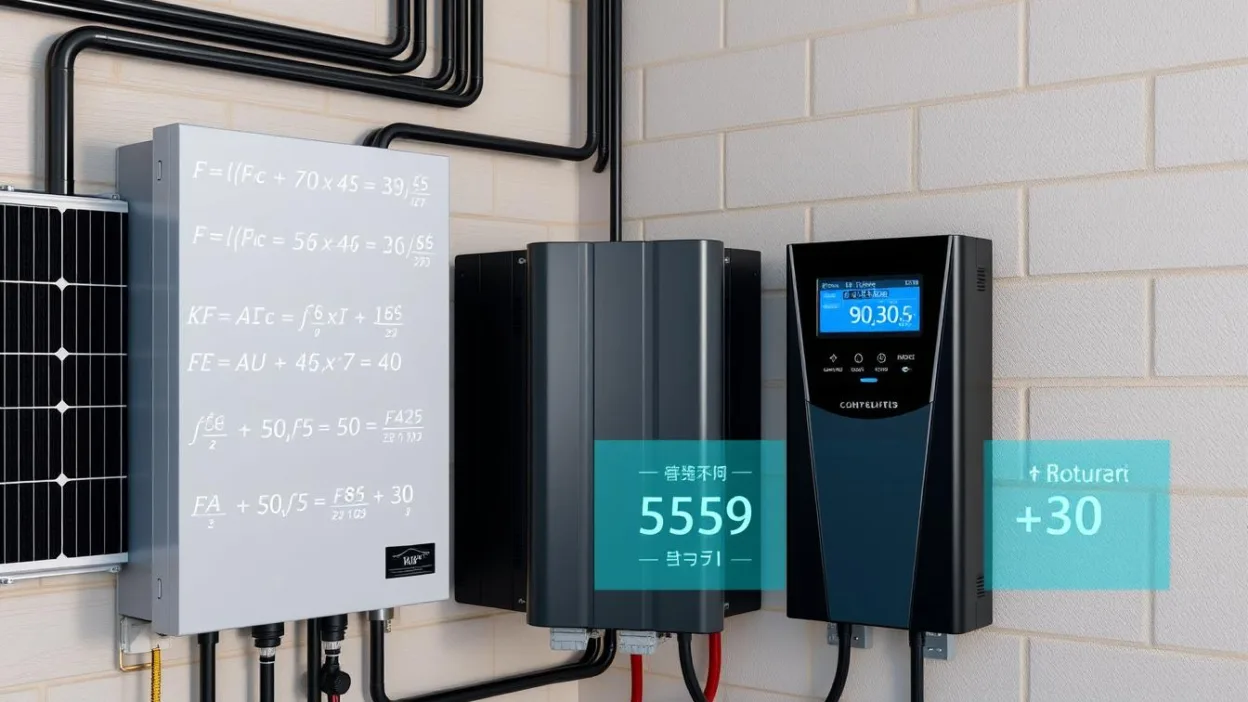Table of Contents
▲
In this comprehensive guide, we’ll explore the essential calculators that take the estimation out of solar battery sizing. From determining the right capability for your energy needs to calculating specific backup times during failures, these tools ensure your renewable energy investment delivers maximum returns. Let’s build a solar system that’s powerful, reliable, and perfectly customized to your life.
Why Proper Solar Battery Sizing Matters
Getting your solar battery system size wrong doesn’t just hurt performance, it can cost you thousands in wasted money, undependable power, and shortened machinery life. Whether you’re going isolated or just adding backup power, understanding these key pain points will help you avoid costly mistakes.

Performance Issues
A miniature battery system leaves you abondoned when you need power most. Imagine your battery draining completely during a failure, leaving serious appliances powerless. On the other hand, a big system means paying for capability you’ll rarely use, especially in areas with limited solar manufacturing.
Financial Impact
Incomapatible elements exhaust your budget. A huge battery paired with tiny solar panels means your storage never fully recharges. Many solar tax credits and utility discounts require specific system sizing for eligibility. Guess wrong, and you could miss out on thousands in savings.
Batteries regularly exhausted below their recommended Depth of Discharge (DoD) can lose half their expected lifetime. Instead of 10+ years of service, you’re replacing expensive batteries in just 5 years.
Using solar battery calculators removes these risks by providing accurate sizing suggestions based on your specific energy needs, location, and tools requirements. Let’s explore the important calculators you need.
Essential Solar Battery Calculators

Different features of your solar battery system require specific calculations. Here are the crucial calculators you need for a properly sized and productive system.
Solar Charge Controller Calculator
A properly sized charge controller prevents damage to your batteries and assures productive charging. This calculator helps match your controller to your panel voltage and recent criteria.

The solar charge controller calculator helps you:
- Determine the correct amperage rating based on your solar array size
- Choose between PWM and MPPT controllers based on your system voltage
- Calculate voltage drop across controller connections
- Size wiring suitably to reduce power loss
Battery Capacity & Size Calculator
Determining the right battery capability is critical for meeting your energy needs. This calculator helps you convert between amp-hours (Ah) and watt-hours (Wh) while accounting for differences between lithium and lead-acid batteries.

Remember: A 100Ah lithium battery at 12V equals 1,200Wh (or 1.2kWh), but you can typically use 80-100% of this capacity. A lead-acid battery of the same size might only provide 600Wh of usable energy due to its 50% recommended depth of discharge.
The battery bank size calculator helps you:
- Calculate total energy storage needs based on daily usage
- Convert between amp-hours and watt-hours for different battery types
- Account for depth of discharge limitations
- Determine best battery bank arrangement (series vs. parallel)
Battery Backup Time Calculator
When power failure impact, knowing exactly how long your battery can power necessary devices is critical. This calculator provides specific execution estimates based on your battery capability and load needs.

Example calculations:
| Battery Capacity | Load | Backup Time | Notes |
| 200Ah (12V) Lithium | 500W | ~4.8 hours | 80% DoD, 90% inverter efficiency |
| 150Ah (12V) Lithium | 300W | ~6 hours | 80% DoD, 90% inverter efficiency |
| 100Ah (12V) Lead-Acid | 200W | ~3 hours | 50% DoD, 90% inverter efficiency |
Battery Charging Time & Life Calculator
Optimize your battery’s lifetime and understand charging cycles with this calculator. Factors like depth of discharge (DoD) and charging efficiency considerably impact how long your batteries will last.

This calculator helps you:
- Estimate charging time based on solar array size and battery capacity
- Calculate expected battery lifespan based on usage patterns
- Optimize depth of discharge settings for maximum battery life
- Account for temperature effects on charging efficiency
Solar Panel Angle Calculator
Maximize energy production by optimizing your solar panel tilt angle. This calculator determines the ideal angle based on your location and season, assuring maximum charging efficiency for your battery system.

The optimal angle varies by:
- Latitude (general rule: tilt angle = latitude for year-round optimization)
- Season (latitude +15° in winter, latitude -15° in summer)
- Local weather patterns and shading considerations
A properly angled solar panel can produce up to 25% more energy than a poorly positioned one, directly affecting how quickly and efficiently your batteries charge.
5 Common Solar Battery Calculator Mistakes

Even with calculators, people often make these critical errors when sizing their solar battery systems:
Common Mistakes to Avoid
- Ignoring Temperature Effects – Battery capacity can decrease by up to 40% in cold weather. Always factor in your local climate when calculating backup times.
- Forgetting Inverter Efficiency – Most inverters are only 85-95% efficient, meaning you lose 5-15% of your battery power in the conversion process.
- Underestimating Surge Requirements – Motors and compressors (like refrigerators) need 3-7 times their running wattage to start up. Your battery and inverter must handle these surges.
- Using Nameplate Ratings Only – Actual power usage often differs from device labels. Measure real-world usage with a power meter for correct calculations.
- Not Planning for System Growth – Energy needs typically increase over time. Add 20-30% capacity to your calculations to suit future enlargement.
Get Expert Help With Your Solar Battery Sizing
Still not sure about your calculations? Our solar experts can help you establish the perfect battery size for your specific needs.
Recommended Solar Battery Calculator Tools
Based on our examination of precision, easy to use, and comprehensive features, here are the top solar battery calculators available online:

PVWatts Calculator
Developed by the National Renewable Energy Laboratory (NREL) API, this calculator provides highly accurate solar production estimates based on your specific location.

Solar ROI Calculator
Combines system sizing with financial assessment to help you understand both technical needs and return on outlay for your battery system.

Specially designed for off-grid systems, this calculator excels at determining battery bank size for complete energy independence.
Pro Tip: Use multiple calculators and compare their results. If you get significantly different suggestions, double-check your inputs or discuss with a solar expert.
Real-World Solar Battery Sizing Example

Let’s walk through a practical example of sizing a solar battery system for a typical American home:
Scenario: 2,000 sq ft Texas home with partial backup needs
- Daily energy consumption: 30 kWh
- Critical loads to backup: Refrigerator, lights, internet, select outlets (approximately 10 kWh/day)
- Desired backup duration: 2 days
- Battery type: Lithium (LiFePO4) with 80% usable capacity
- Average peak sun hours in Texas: 5 hours/day
Step 1: Calculate Required Battery Capacity
Required capacity = (Daily essential load × Backup days) ÷ Depth of discharge
Required capacity = (10 kWh × 2 days) ÷ 0.8 = 25 kWh
This means we need a 25 kWh battery system to power essential loads for 2 days.
Step 2: Calculate the Required Solar Array Size
To recharge the battery in one day:
Solar array size = (Battery capacity ÷ Peak sun hours) × 1.2 (system losses)
Solar array size = (25 kWh ÷ 5 hours) × 1.2 = 6 kW
This means we need a 6 kW solar array to fully recharge our battery system in one day, accounting for system inefficiencies.
Step 3: Choose Inverter Size
Calculate maximum simultaneous load:
- Refrigerator: 800W (start-up surge: 1,600W)
- Lights: 200W
- Internet/Electronics: 300W
- Miscellaneous outlets: 1,000W
Total running watts: 2,300W
Accounting for surges: 3,100W
Recommended inverter size: 4,000W (providing headroom for additional loads)
Calculate Your Custom Solar Battery System
Ready to size your solar battery system? Use our comprehensive calculator to get personalized suggestions based on your specific energy needs and location.
Conclusion: Power Your Life with Confidence

Choosing the correct solar battery size is vital for optimizing efficiency, saving money, and ensuring trustworthy power. By using the solar battery calculators we’ve explored, you can avoid the hazards of undersizing or oversizing your system.
Remember that proper sizing isn’t just about today’s needs it’s about building adaptable energy system that will serve you for years to come. Whether you opt for a specially designed system or an all-in-one solution, using these calculators takes the assumptions out of solar planning.
Start smart, save money, and enjoy unbroken power by sizing your system right the first time. Which calculator will you try first? Share your experience in the comments below!




